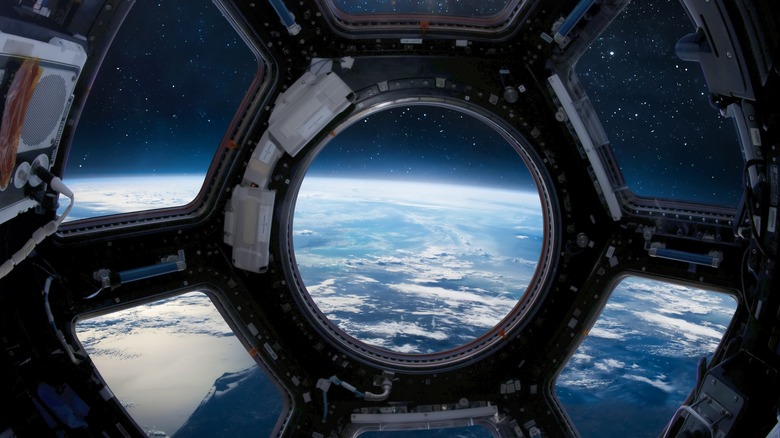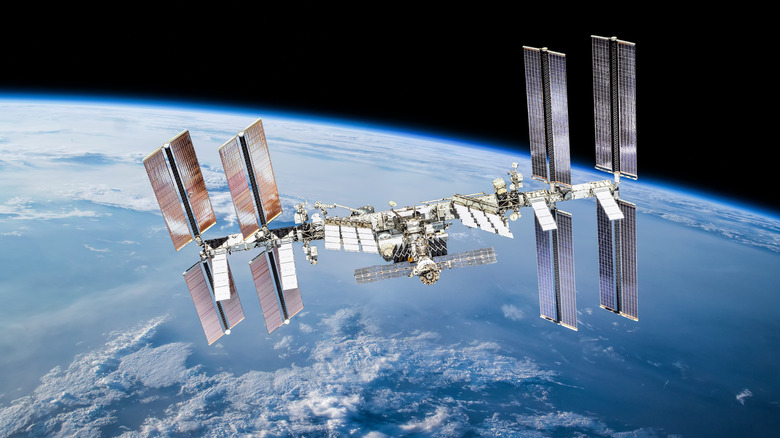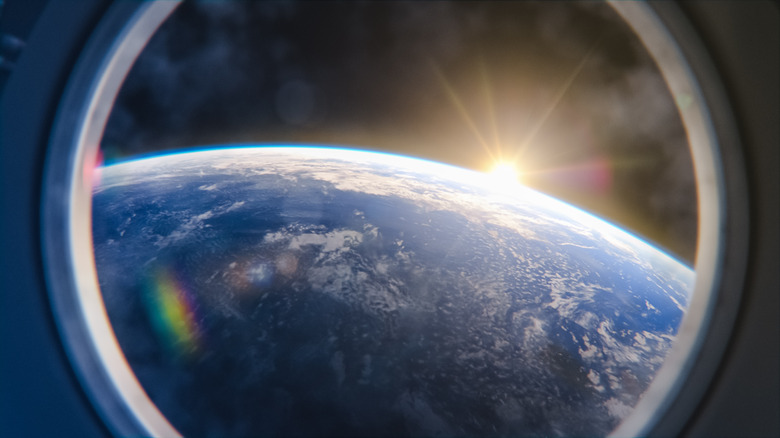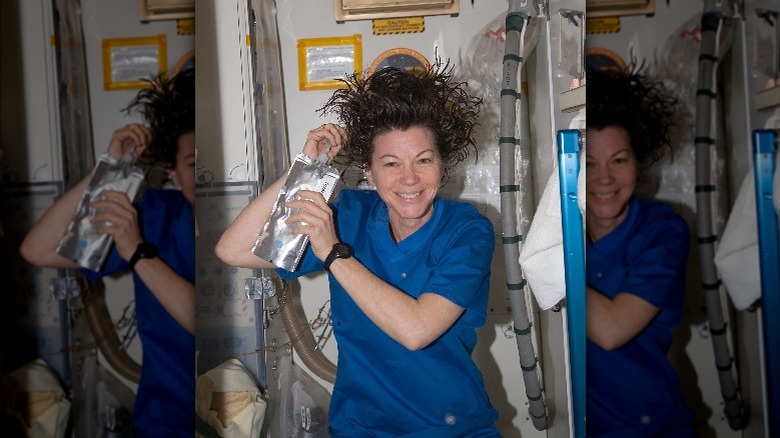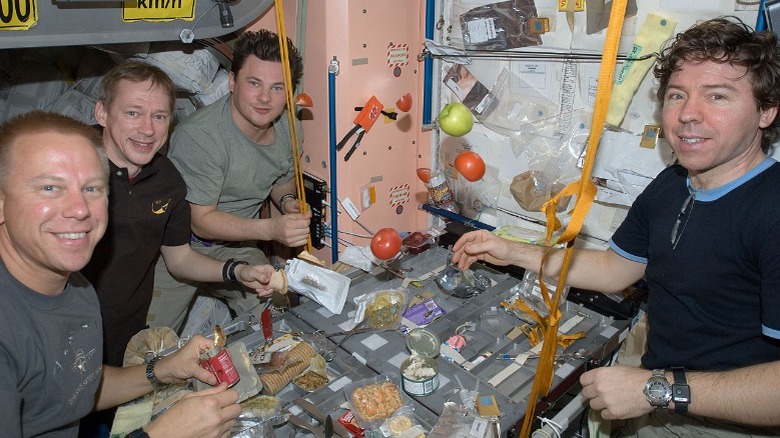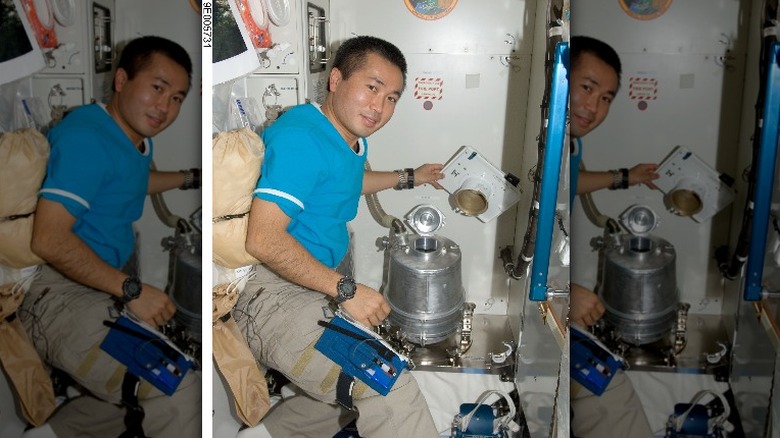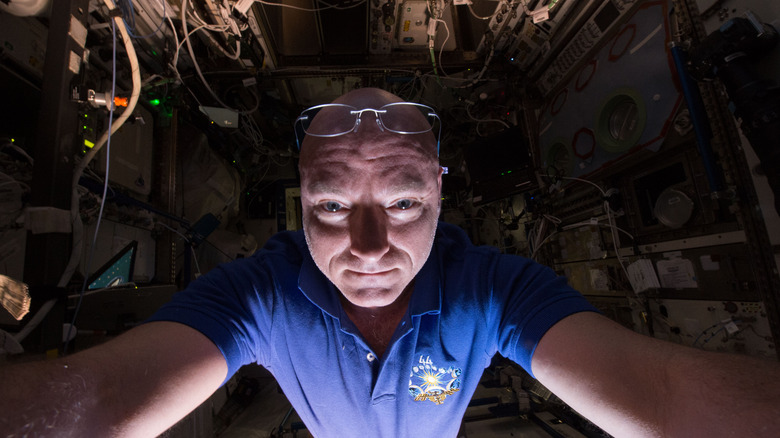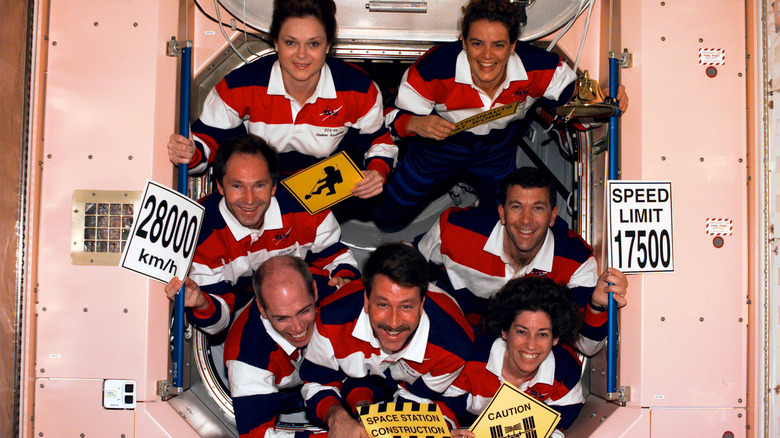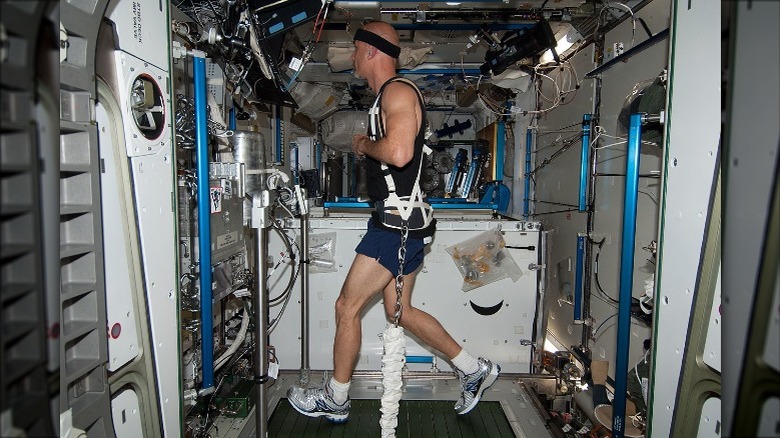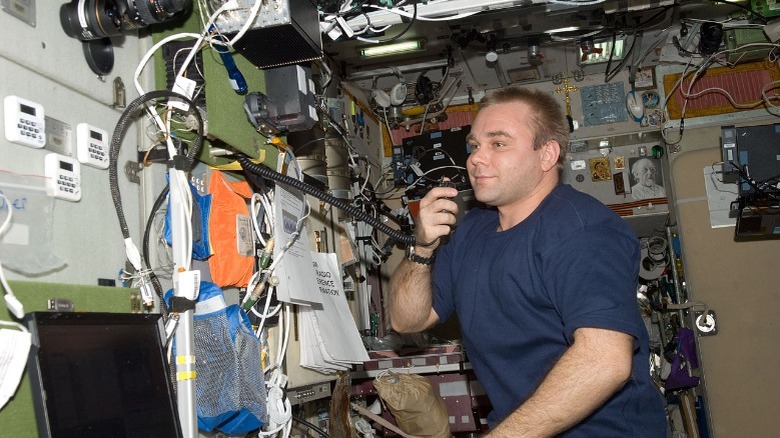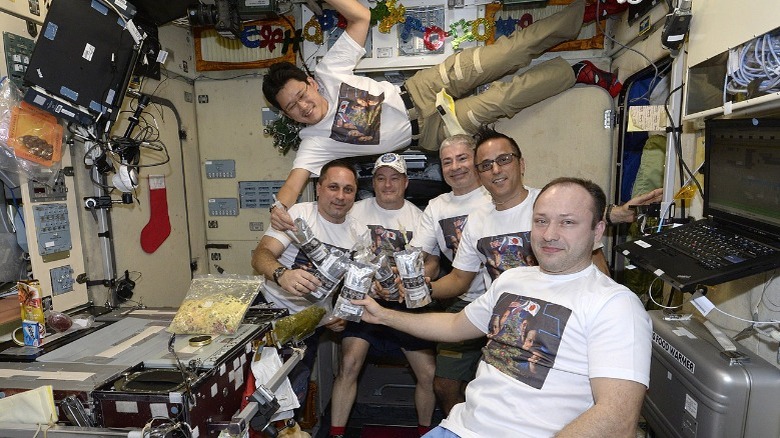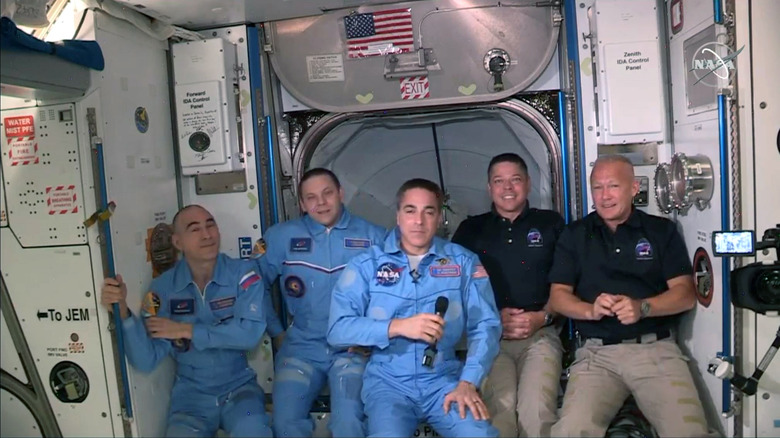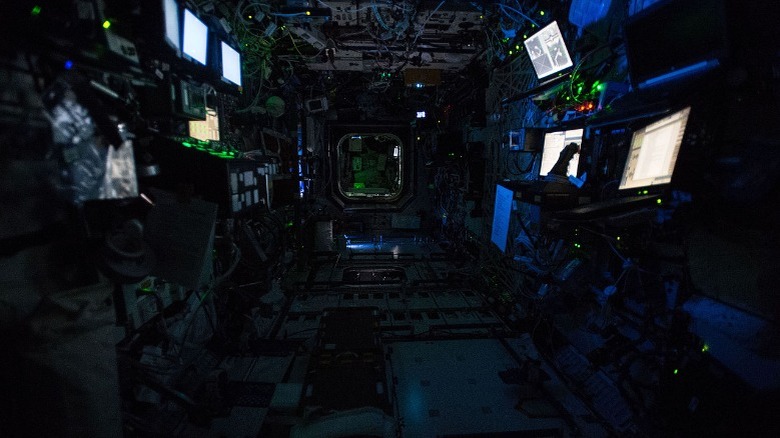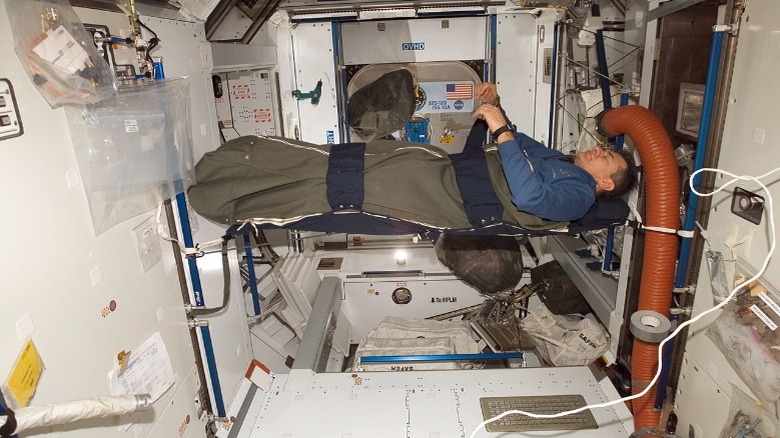This Is What An Astronaut On The ISS Does In A Day
Being an astronaut is so obviously awesome that it seems every kid decides they want to be one by the time they are 5 years old. Of course, once those kindergarteners grow up, they learn that actually becoming an astronaut is unbelievably difficult, which is why most of us never give it another thought and there are not currently a couple million people orbiting Earth.
But some of those little kids decide putting in all that work is worth it, and then if they manage to pass a whole variety of other criteria that work has nothing to do with (like being shorter than 6'4, according to Britannica) many, just maybe, they might get the chance to go into outer space.
These days, the main location for humans hanging out high in the heavens is the International Space Station or ISS. While being selected for a months-long mission there is an honor, it's also a job. And once the astronauts are up there, the hard work they have been doing their whole careers continues. Here's what the average day is like for astronauts on the ISS.
Absolutely everything is scheduled
An astronaut is probably used to a pretty rigorously scheduled workday on earth, but that is nothing compared to what they face once they arrive at the ISS. For the rest of their mission (usually around six months, according to the Kennedy Space Center), virtually every single thing they do is scheduled. Anyone who has an impulsive personality might not be the right fit for this particular assignment.
Click Orlando explains that each astronaut's day is planned out in 5-minute increments. And it's not even the astronaut who gets to make up that schedule, but a special team at NASA. It's a tough job since they have to take so many variables of life in space into account. Once the astronaut has their schedule, which includes when they eat, sleep, work, and exercise, even when they have free time (if you have to schedule your free time, is it really that free?), they have to stick to it.
But what if they aren't hungry when it's time to eat? Too bad, they need the calories. And if they can't sleep during that allotted time? While they are allowed to read a book since you can't exactly force someone to fall asleep if they aren't tired, the astronauts also can't make up for that missed sleep with a nap the next day.
What exactly is a 'day' in space?
So an astronaut's entire day is scheduled, which brings up the question – what even is a day in space? After all, our idea of a 24-hour period of light and dark is based on our feet being firmly on the ground down on Earth. The length of a day is different on all the planets in the solar system and when you're orbiting above one, the whole concept goes out the window.
According to the European Space Agency, a day on the ISS is based around what the astronauts' bodies want, not any rising or setting of the sun (considering those on board experience over a dozen sunrises every 24 hours, trying to base their lives around that marker would be chaos). Regardless of what light and dark are doing around them, the astronauts are still inhabiting bodies that spent millions of years on Earth and are finely tuned to the 24-hour Earth day. That means the ISS runs on "biological time," per the Space Center Houston.
However, the swings between light and dark every 45 minutes do mess with that circadian rhythm, so the artificial lights on the ISS come in different intensities to try to help mimic the day-to-night cycle on Earth.
Waking up
According to the European Space Agency, the ISS astronauts all wake up to an alarm in the "morning," since even outer space isn't far enough away to avoid that torture. Floating through the cabin, they get dressed. However, they only get to wear clean clothes every three days, and since they can't do laundry on the ISS, once they have three days of soiling on them the clothes become garbage.
The BBC notes that brushing their teeth does involve water, although thanks to the no gravity, the small dollop sticks to the bristles of the brush. Once they finish brushing, they can't spit. That means swallowing the toothpaste every time. Showering is completely out of the question, so bathing is done with damp towels and dry shampoo.
Weirdly, while there is no rule that they have to, many male astronauts still shave on the ISS, even though it involves a lot more work than on Earth. Since they don't want any piece of stubble or shaving cream to float off into the space station and possibly cause damage, precautions must be taken. If they use an electric razor, it needs to be next to a fan that's reversed to suck the hair up. Chris Hatfield maintained a fabulous mustache during his time on the ISS, so it's obviously worth the effort.
Eating
You probably think of astronaut food as that freeze-dried ice cream you had as a kid. Well, the European Space Agency says things have moved on since the time that sort of food was necessary. These days, the food they eat is (apparently) much tastier and has far more variety.
Like with everything else on board, the goal is to eat food in such a way that no crumbs will float off and possibly cause havoc. This means sipping soup out of a pouch with a straw and being extra careful when eating more solid foods. NASA explains that astronauts use water to rehydrate pasta, and even have access to desserts like brownies. Salt and pepper are available in liquid form, and they need a lot, as well as other spices, since the astronauts' sense of taste gets worse the longer they are in space.
While there is no refrigerator on the ISS, there is an oven, and the cosmonauts on the Russian side even bring tinned foods that can be heated up while still in the can, a holdover from the Cold War days, per the BBC. Occasionally the ISS even gets deliveries of fresh fruit along with their other cargo, which must be a real treat. Another special occasion is Sundays, the only day of the week that the various astronauts' schedules allow them to sit down at the table and eat all together as a group.
Going to the bathroom
While they might have found ways around showering, even on the ISS, astronauts still have to answer the call of nature. And going to the bathroom in zero gravity is an ordeal. However, the European Space Agency explains that it is a luxury earlier astronauts could only dream of, as before the space toilet there were ... bags. They pooped in bags.
The ESA does admit that the toilet on the ISS looks "somewhat intimidating" and that even highly trained astronauts who are prepared for anything can find the thing difficult to use. First, they need to grab their "personal urinal funnel," as NASA puts it. Since there's no gravity to hold them down, the astronauts use restraining bars. And, of course, microgravity means the toilet doesn't use water, but a strong suction fan, essentially a vacuum cleaner, per JAXA, which moves whatever was left in the toilet to a wastewater container. It does this continually, unlike, say, an airplane toilet, since there can't be any chance of poop or pee floating away.
If you are shy, the worst thing about the toilet might be that there is no door, just a curtain between it and the rest of the ISS. However, JAXA assures anyone who was about to give up their astronaut dreams that the ISS is so loud due to fans and other mechanical things that no one can hear any of your bathroom noises.
Working
While it seems like just existing on the ISS with all the complications and cramped conditions is a job in itself, the astronauts are, after all, there to work. Considering all the trouble and expense it takes to get them up there, the work they do is super important.
No matter what their other jobs are, the BBC says that every astronaut will spend part of their day working on experiments. In a space station where room is extremely limited, there are a whopping five different research laboratories, indicating how much of the point of being up there at all is the scientific opportunities. The astronauts themselves are not coming up with the experiments, however. Instead, they are told before they head up to the ISS what they will work on, and practice before they go.
Perhaps disconcertingly, one of the most important science experiments the astronauts take part in is just living in space. Their bodies are effectively their own very personal experiments, and NASA explains that researchers back on Earth are eager to find out what such a small amount of gravity does to a body. So the astronauts have to be part of medical experiments while they are up there. It's not just humans that are guinea pigs, so to speak. Experiments on the ISS have included animals from ants to fish to mice.
Cleaning and maintenance
Since the astronauts on board the ISS are completely dependent on the many systems on board working correctly in order to stay alive, a lot of their time is devoted to making sure everything is clean and in working order. NASA compares it to being a homeowner, and the million little tasks that always need doing to keep a house nice and maintained.
Considering they are dealing with life support systems, even something as basic as cleaning a filter has a level of importance you can never get at home. Surfaces must be regularly disinfected. And moving boxes around isn't fun even in microgravity, as the European Space Agency explains astronauts still have to deal with the difficulties of the supplies' mass and inertia.
Where ISS maintenance takes a hard left turn from anything you would do to keep your home in order on Earth is when the repairs involve a spacewalk. The BBC says these are taken extremely seriously. The planning is done weeks in advance, down to the last detail. On the day of the walk, the two astronauts who will be leaving the ISS slowly put on their space suits, making sure to do everything included on the 100-page checklist. This takes about four hours. At that point, their workday has just begun, as the spacewalk can last another 8 hours.
Exercising
While there is still a lot to learn about the effects of microgravity on the human body, one thing we do know is that if the astronauts don't do a lot of exercise in space, their muscles will atrophy and their bones will weaken, per JAXA. This means each astronaut has a punishing exercise regime.
The BBC says those on the ISS are required to work out at least two hours a day — minimum. And while the equipment might look relatively similar to what they would use on Earth, in order to correctly use and get benefits from exercise, there have to be some adjustments. On the treadmill (pictured), for example, astronauts have to strap themselves in or they will float away. Their exercise bike doesn't have a seat, since sitting on one is impossible with so little gravity.
Weights, in particular, are an issue, since while they still have mass in space they have virtually no, well, weight, as NASA explains. The Advanced Resistive Exercise Device (ARED) uses vacuum tubes to recreate the feel and benefit of weightlifting.
Communicating with Earth
The astronauts on the ISS are in constant communication with Earth. While this obviously includes NASA officials and mission control, it could also, in theory, include you.
According to ARISS (Amateur Radio on the International Space Station), the astronauts have their own "ham" radio on the ISS, which they can use to contact anyone with their own ham radio on Earth. Yes, these are the same types of radios made famous by 1970s movies about truckers.
This isn't something the astronauts do infrequently, although they are much more likely to reach out in the morning or evening, since chatting to randos with outdated technology isn't seen as more important than the science they are up there to do during the day. And if you have a ham radio, you don't have to wait for them to contact you but can try to reach out to the ISS yourself. ARISS gives very detailed and helpful information on the equipment and techniques needed to successfully get in contact with the astronauts.
Free time
Since it's so complicated and expensive to send an astronaut to the ISS, you might think NASA tries to wring every last working minute out of them while they are up there. But not only do astronauts have free time scheduled every day (usually in the evening), they even get weekends off, NASA explains.
There's a practical reason for this: Life on the ISS is so stressful, that free time to relax in whatever ways the astronauts need is vital to keep them mentally and emotionally fit. They are even allowed to bring some items of their choosing to the ISS to relax with. Books are a popular choice, and Chris Hadfield became famous for bringing his guitar and making a music video while he was up there.
Other common ways to spend their free time include watching movies (the BBC says these often have a space theme), using Twitter, playing cards, and emailing their loved ones. But often they choose to spend their precious free time simply looking out the windows at Earth, an experience they know they won't be able to recreate after their time on the ISS. The European Space Agency says the view never gets old.
Dealing with your fellow crew members
While Space Nation explains that the ISS is not actually that small, comparing it to a "5-bedroom 2-bathroom home with a gym," there are of course other issues that make living there for six or more months a taxing experience. The biggest difference to living on Earth with roommates in a big house is, of course, that no one can leave. This means if issues arise, they have to be dealt with, since going for a space walk to calm down isn't really an option.
Before the ISS, NASA worked hard to make any group of astronauts into a strong, supportive team. Now? It's all down to what needs to be done on the ISS, and if an astronaut gets the assignment and hates everyone they will be living with, bummer. Usually, they wouldn't even know if they dislike anyone until they are already on board, since they might not even have met their coworkers until that point. To counter this, there are two crew meetings a day where issues get hashed out. And for extra assistance, many astronauts have a weekly teletherapy visit with a mental health professional.
With both Russians and Americans on the ISS, these conflict resolution methods became highlighted after the Russian invasion of Ukraine in 2022, according to Vanity Fair. Despite threats from Russian government officials, the relationships on board the ISS were said to still be very strong.
Dealing with emergencies
When you're in space with just a handful of other people, emergencies of any kind take on a new level of urgency. The things that can go majorly wrong while orbiting Earth range from medical to mechanical, and the astronauts have to be prepared for all of them. While, thankfully, they aren't a daily occurrence, the possibility is always there.
According to JAXA, every astronaut on board gets at least some basic training in emergency medicine, including resuscitation procedures for if another crew member collapses (or rather, floats aimlessly) from a heart attack. But only one of the astronauts, the Crew Medical Officer, gets more advanced training in saving lives in space. They are in charge of knowing how to use all the medical supplies on board, including drugs.
In a mechanical emergency, it's not just one astronaut in danger, but everyone on the ISS. As recently as 2021, The Atlantic reports, NASA's mission control made the "unnerving" discovery that the ISS was slightly out of its expected orbit. The astronauts were informed, and both the U.S. and Russia worked to fix the issue, which was so bad that those on the ISS lost contact with Earth for minutes at a time as they tried to reconfigure their systems from inside the space station.
Sleeping
NASA explains that an astronaut's schedule allows for eight hours of sleep a night, but actually getting a good night's sleep in space can be extremely complicated. For one, the astronauts have to tether themselves down. The European Space Agency writes that while occasionally someone will think floating free during the night would be cool, they usually give up when they awake stuck to an air filter. So, nights are passed tied down in a sleeping bag in each crew member's small cabin. If they do choose to tie their bed down elsewhere, it's important they get good airflow. Because of the microgravity, an astronaut can actually start to asphyxiate on their own exhaled carbon dioxide if it isn't blown away.
Other things working against an astronaut's beauty sleep are the noise of the ISS itself, which is never quiet, and the noise of other astronauts, since space doesn't stop people from snoring. Some astronauts feel motion sick when trying to sleep, and getting up to pee in the middle of the night is rather complicated. Then there's the fact the sun keeps rising and setting during those 8 hours, meaning an eye mask can be vital, per JAXA.
Once they do get to sleep, however, many astronauts report dreaming they are weightless.
